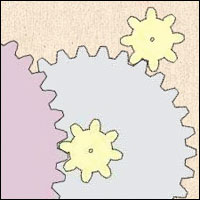In a clock the minute hand runs at one sixtieth the speed of the second hand. The clockmaker could
connect the two with a 60:1 gear but even with a small 10 tooth drive wheel she would still need a 600 tooth main wheel!
To make the mechanism more compact horologists (clock and watch makers) connect more that one gear
pair together.
No iFrame ‘;
print ‘Using HTML 5 ‘;
}
else{
print’
‘;
print ‘Using Flash‘;
}
?>
In the example above there is an 8:30 gear connected to an 8:40 gear pair. To calculate the final gear reduction it is just a case of multiplying the two together. (8 x 8) : (30 x 40) which is 64 : 1200 or simplified 1 : 18.75
Simply put, turn the small gear or the right 18.75 times for each turn of the large gear.

In the example of a clock the clock maker is looking to create a 60:1 reduction. Rather than using the 60:1 gear shown above, our hypothetical clock maker could add another gear to the animated gear train at the top of the page, this time with a ratio of 1: 3.2 to complete the conversion to 1 : 60. In the gear train below the four gears can be make much more compactly than the 600 tooth monster meaning that the whole mechanism can fit into a smaller case.

In the lower right of the picture above I have scaled down the gear train so that the ten toothed gear wheel is the same size as the one matched with the 600 tooth gear in the other picture. This shows just how much space is saved!


